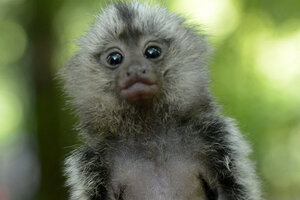Could fossilized teeth solve a monkey mystery?
The discovery of prehistoric molars in Peru could fill a major gap in our understanding of primate evolution.

A young common marmoset (Callithrix jacchus) at the zoo in Eberswalde, Germany.
AP Photo/Theo Heimann
For some paleontologists, uncovering the secrets of primate evolution is like pulling teeth.
Newly discovered fossilized molars, described this week in Nature, extend the fossil record of New World monkeys (Platyrrhini) back about 10 million years. The teeth were unearthed in Santa Rosa, Peru by an international team of researchers that includes Marcelo Tejedor, a primatologist at the Argentinian research institute Centro Nacional Patagónico.
Platyrrhini is a distinct subgroup of primates that includes marmosets, howler monkeys, and spider monkeys, animals native only to Central America, South America, and parts of Mexico. They are the only primates with prehensile tails, which allow them to dangle from tree branches. Due to their unique morphologies and singular habitats, uncovering the group’s ancestral origins has proven a challenge.
But new fossil specimens, estimated to be about 26 million years old, might help lift the fog. The most complete molars belong to a newly discovered species, which Dr. Tejedor’s team has dubbed Perupithecus ucayaliensis. Since the remains were found in Peru, this ancient monkey is thought to be an ancestor of modern platyrrhines. However, fossil analysis suggests that Perupithecus probably looked more like an Old World primate – at least in the teeth.
Old World primates, like baboons and macaques, are native to the African continent. New World primates are so called because they are native to South America, rather than Africa.
Scientists believe that, some 40 million years ago early simians forked into two separate evolutionary paths. One group, the catarrhini, now includes Old World monkeys as well as orangutans, gorillas, chimpanzees, and humans. The other group, the platyrrhini, includes the five families of monkey native to the Americas.
But the fossil record remains silent on how the two groups separated in the first place.
“By that time, Africa and South America were separated by a considerable distance across the Atlantic,” Tejedor says, “although probably about the half the distance that exists today. The possible migration is a matter of speculation, but some authors have hypothesized that island chains along the sea – a product of the volcanic activity of the mid-Atlantic ridge – between northeastern South America and western Africa may have allowed the passive migration through the ocean on floating vegetation, and the islands were some kind of stops in that trip. There are examples today of animals traveling on floating vegetation for long distances. However, it is purely speculative.”
Although these scant remains represent an incomplete picture of Perupithecus, co-author Kenneth Campbell, of the Natural History Museum of Los Angeles County, suggests that teeth are actually quite telling.
“The teeth of mammalian species are very distinctive,” Dr. Campbell says, “and in vertebrate paleontology, it is a common practice to describe new species on teeth alone. Often, that is the only part of a mammal that is preserved.”
“For New World monkeys, teeth are informative and we can reconstruct phylogenies based on teeth alone,” Tejedor adds. “They have characteristics reflecting diets – therefore a crown of a frugivorous primate strongly differs from an insectivorous one because of shape of the cusps, development of crests connecting the cusps, cusp height, etc.”
With just a few molars to work from, Tejedor is able to imagine what this ancient monkey might have looked liked.
“They were small – more or less the size of a living tamarin like Callimico – with a weight of 350 grams,” Tejedor says. “And probably the diet was similar, relying more on insects and some fruits.”
Researchers have also gleaned insights about the environment in which Perupithecus lived.
“Based on what we know about primates in general and the types of animals found in association with the Santa Rosa primates, we can interpret the environment as forested with abundant water,” Campbell says. “Perhaps swampy. An environment very conducive to hosting a wide variety of rodents and marsupials, as well as the primates.”
But Tejedor and Campbell shy away from sweeping statements – as informative as teeth are, they don’t tell the whole story.
“Of course, the fragmentary nature of these fossils is the main problem,” Tejedor says, “because in such primitive stages of evolution of New World monkeys we should have additional evidences, such as skulls or post-cranial elements. That would help a lot to clarify their relations.”
While this discovery has made inroads linking New and Old World monkeys, it has also raised new questions about the origins of these unique species.
“Since these monkeys have an unexpected morphology – most authors believed that tamarins and marmosets, the smallest New World monkeys, were derived, more modern forms, and nobody expected to find their morphology in the oldest records – we have to explore the ancestral morphotype of New World monkeys,” Tejedor says. “I spent my whole career searching for a different pattern for ancestral South American primates, and this finding from Peru completely changed my previous expectations and opens an amazing challenge.”

